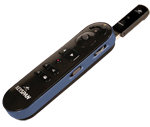In the third of our series on personal styling, Christina Kautzky gets expert tips on making a presentation seem like a breeze
The art of the impactful presentation can seem an elusive beast at the best of times. From childhood, tips on how to look appropriate and present effectively abound: stand up straight, speak slowly and clearly, don’t fidget, make eye contact, don’t be nervous… and the list goes on. But what about the less obvious factors affecting the look, feel and audience reception of a presentation? And how can presenters control these factors to their advantage? From venue to intonation, psychology to technological gadgets, details and planning can vastly improve the effectiveness of any presentation.
A sense of place
Dr Amantha Imber, who is head of Australian creative-thinking company Inventium and author of The Creative Formula, explains that there are several easy steps presenters can take to transform a dry, run-of-the-mill conference room into a comfortable environment in which people will be alert, receptive and responsive. “When exposed to the natural environment – even posters, plants or outside venues – people are more relaxed and calm, but it energises their brains,” Imber says, translating to increased attention levels. If available, choose a room with a window to the outside world, letting natural light in and giving the audience a break from the view of the water cooler.
“When exposed to the natural environment – even posters, plants or outside venues – people are more relaxed and calm, but it energises their brains,” Imber says, translating to increased attention levels. If available, choose a room with a window to the outside world, letting natural light in and giving the audience a break from the view of the water cooler.Additionally, she points out that warm-coloured environments with oranges and yellows have been proven to make people happier than those with cooler colours. And that doesn’t mean painting the walls; a vase of orange flowers or a tablecloth can do the trick. Natural materials are also preferable to synthetics, so wooden tables and chairs with natural fibres are best to put people in the right frame of mind before the presenter speaks.
Depending on the aim of the presentation, having few distractions or many in the room can contribute to the right outcome. For serious or technical presentations, a simple room layout that focuses on the speaker and the presentation materials is best.
However, even if presenting a business plan or discussing how to crunch next year’s numbers, allowing listeners to play with intelligent toys – such as Rubix cubes or metal puzzles – will energise and stimulate the right side of the brain, which is associated with logic and maths.
The presenter
In addition to the tips mum always gives out about looking presentable and smiling, Dr Carol Fleming, a voice coach and communications trainer, advises presenters to think about the audience and not to focus so much on themselves. This is particularly true with the issue of stage – or presentation – fright.
“People are completely wrong about stage fright. They think the audience is going to criticise them,” says Fleming. “The unfortunate fact of the matter is that people are not really paying that much attention to you; they are probably thinking about lunch or checking their BlackBerry. This means you (need) to make much more of an effort to catch and hold their attention.”
Giving a speech or making a presentation is about the content, not the person, so paying attention to what the audience sees and what they hear, rather than how it might be judged, is the best first step toward a successful presentation.
What a particular listener hears – the core message that is conveyed – depends on verbal, auditory and visual cues. As an audience receives information, each person is unconsciously listening for aural clues to mentally organise what is being said.
As such, intonation and emphasis placed on syllables and words need to match the listeners’ expectations. In an international workplace, this becomes a nearly impossible challenge, but with the right physical cues, the key messages in the presentation will still come across clearly.
Changes in demeanour can make an audience more responsive to information, including standing upright and making eye contact with the listeners. This also enforces individual points as the presenter speaks, as do well-placed pauses between points.
“Very few people realise the importance of the pause,” explains Fleming. “It’s the point at which your audience gets to catch up with you and receive information.”
Before the punch line to a joke or before an important piece of information, she suggests pausing to allow listeners to make the mental jump forward.
The presentation
With the help of a decent IT department and a tutorial on PowerPoint, almost everyone is capable of putting together a well laid-out presentation. However, many people forget that the presentation materials should support the speaker, not the other way around.As such, presenters should avoid looking at the screen while speaking, focusing on the audience and their reactions instead. The slides should be designed to present information the audience needs to see, not the words the speaker wants them to hear. Images, graphs, quotes or key points to support the overarching message will enhance what is being said.
Whether presenting on business trends, creative ideas or a report detailing year-end losses, technology has evolved where presentations are concerned, allowing speakers to spend more time delivering the message, and less time fiddling with chords. The caveat to this is making sure that it all works. Simple, yes; but often forgotten. Nothing is capable of derailing an audience’s attention more than a glitch that shuts down a presentation halfway through.
But whatever happens, the crucial point to remember is not to panic and to focus on the information that needs to be delivered. The key to a great presentation is not necessarily the most compelling topic – it is the ambience, the presence and poise of the speaker, the ability to articulate points clearly, and easy incorporation of any technology and materials. To reiterate Fleming’s point, “you are overestimating your importance if you think that giving a speech is about you”.
Focus on the task at hand and how best to deliver the key messages and odds are that the group leaves the meeting with a positive overall impression.
Tools of the trade
Today, presentation tools have gone far beyond that pesky laser pointer. Here are some useful devices that will allow presenters to integrate the best in tech gadgets without taking a course in geek-speak.Keyspan Presentation Remote Pro (US$79)
 This genius device lets presenters move around the room – up to 30m from the computer – to flip through slides on PowerPoint and scroll through the computer without having to look at the laptop. This user-friendly remote is compatible with both Windows and OS X-based machines, doubles as a mouse, and yes, has a laser too.
This genius device lets presenters move around the room – up to 30m from the computer – to flip through slides on PowerPoint and scroll through the computer without having to look at the laptop. This user-friendly remote is compatible with both Windows and OS X-based machines, doubles as a mouse, and yes, has a laser too. Victorinox Presentation Pro (US$170 to US$320)
This is a complete presentation tool with a rugged edge. Tucked in next to a nail file, scissors and blade to fend off any unruly audience members is a removable 8GB to 32GB USB drive with fingerprint authentication, the tried and true laser pointer, and a Bluetooth remote control for Windows-only PC or laptop presentations.








